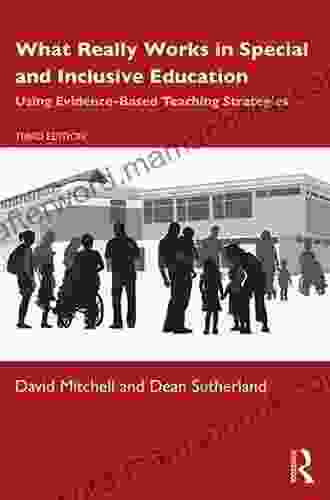What Really Works in Special and Inclusive Education: Evidence-Based Practices for Success

4.9 out of 5
| Language | : | English |
| Text-to-Speech | : | Enabled |
| Enhanced typesetting | : | Enabled |
| Word Wise | : | Enabled |
| File size | : | 2909 KB |
| Print length | : | 456 pages |
| Screen Reader | : | Supported |
Special and inclusive education play a vital role in ensuring that all students, regardless of their abilities or disabilities, have the opportunity to reach their full potential. However, the effectiveness of these educational approaches relies heavily on the implementation of evidence-based practices (EBPs). EBPs are strategies and interventions that have been scientifically proven to be effective in improving student outcomes.
In this article, we delve into the realm of EBPs in special and inclusive education, exploring the latest research and best practices that can make a real difference in the lives of students with disabilities. We will cover a wide range of topics, including differentiated instruction, assistive technology, positive behavior interventions, and collaboration.
Differentiated Instruction
Differentiated instruction is a key EBP that involves tailoring instruction to meet the specific learning needs of each student. This means understanding the unique strengths, weaknesses, interests, and learning styles of all students and adjusting the curriculum and teaching methods accordingly.
Some effective strategies for differentiated instruction include:
- Tiered assignments: Providing students with assignments that vary in difficulty and complexity
- Learning centers: Creating designated areas in the classroom where students can engage in hands-on activities and explore different learning modalities
- Flexible grouping: Grouping students based on their abilities and learning needs, rather than age or grade level
- Choice boards: Offering students a range of activities and assignments to choose from, allowing them to personalize their learning
Assistive Technology
Assistive technology (AT) refers to any device or system that helps individuals with disabilities perform tasks that they would otherwise be unable to do or do with difficulty. AT can play a significant role in supporting students with disabilities in the classroom by:
- Improving communication: Speech-generating devices, communication boards, and augmentative and alternative communication (AAC) apps
- Enhancing mobility: Wheelchairs, walkers, and other mobility aids
- Supporting learning: Text-to-speech software, screen readers, and other assistive technology tools
- Increasing independence: Adapted utensils, keyboards, and other devices that make everyday tasks easier
Positive Behavior Interventions
Positive behavior interventions (PBIs) are strategies designed to prevent and address challenging behaviors in students. PBIs focus on identifying the underlying causes of problem behaviors and implementing proactive interventions to reduce their occurrence.
Some effective PBIs include:
- Functional behavior assessment (FBA): Identifying the function or purpose of the challenging behavior
- Behavior intervention plan (BIP): Developing a plan that outlines strategies for preventing and responding to challenging behaviors
- Token economy: Rewarding students for positive behaviors with tokens that can be exchanged for privileges
- Social skills training: Teaching students appropriate social behaviors, such as communication, problem-solving, and conflict resolution
Collaboration
Effective special and inclusive education requires strong collaboration among teachers, parents, students, and other professionals. This collaboration is essential for:
- Developing and implementing individualized education programs (IEPs): Ensuring that each student has an educational plan that meets their unique needs
- Providing ongoing support: Offering students with disabilities the necessary academic, social, and emotional support to succeed
- Monitoring progress: Regularly assessing student progress and making adjustments to the educational plan as needed
- Involving parents and families: Partnering with parents and families to ensure that students are receiving the support they need outside of the classroom
The implementation of evidence-based practices is crucial for the success of special and inclusive education. By using these strategies and interventions, educators can create learning environments that empower students with disabilities to reach their full potential. It is important to remember that every student is different, and what works for one student may not work for another. The key is to find the right combination of EBPs that meet the individual needs of each student and support their unique learning journey.
4.9 out of 5
| Language | : | English |
| Text-to-Speech | : | Enabled |
| Enhanced typesetting | : | Enabled |
| Word Wise | : | Enabled |
| File size | : | 2909 KB |
| Print length | : | 456 pages |
| Screen Reader | : | Supported |
Do you want to contribute by writing guest posts on this blog?
Please contact us and send us a resume of previous articles that you have written.
 Top Book
Top Book Novel
Novel Fiction
Fiction Nonfiction
Nonfiction Literature
Literature Paperback
Paperback Hardcover
Hardcover E-book
E-book Audiobook
Audiobook Bestseller
Bestseller Classic
Classic Mystery
Mystery Thriller
Thriller Romance
Romance Fantasy
Fantasy Science Fiction
Science Fiction Biography
Biography Memoir
Memoir Autobiography
Autobiography Poetry
Poetry Drama
Drama Historical Fiction
Historical Fiction Self-help
Self-help Young Adult
Young Adult Childrens Books
Childrens Books Graphic Novel
Graphic Novel Anthology
Anthology Series
Series Encyclopedia
Encyclopedia Reference
Reference Guidebook
Guidebook Textbook
Textbook Workbook
Workbook Journal
Journal Diary
Diary Manuscript
Manuscript Folio
Folio Pulp Fiction
Pulp Fiction Short Stories
Short Stories Fairy Tales
Fairy Tales Fables
Fables Mythology
Mythology Philosophy
Philosophy Religion
Religion Spirituality
Spirituality Essays
Essays Critique
Critique Commentary
Commentary Glossary
Glossary Bibliography
Bibliography Index
Index Table of Contents
Table of Contents Preface
Preface Introduction
Introduction Foreword
Foreword Afterword
Afterword Appendices
Appendices Annotations
Annotations Footnotes
Footnotes Epilogue
Epilogue Prologue
Prologue Steven Lovink
Steven Lovink Frank Rutledge
Frank Rutledge Forest Walker Davis
Forest Walker Davis 4th Edition Kindle Edition
4th Edition Kindle Edition Franco Buffoni
Franco Buffoni Omar Khayyam
Omar Khayyam Daniel Tudor
Daniel Tudor William Martin
William Martin Ted Olson
Ted Olson Universal Politics
Universal Politics David A White
David A White Denise Pikolycky
Denise Pikolycky Brent Weeks
Brent Weeks Shabbir Bhimani
Shabbir Bhimani Steven F Lott
Steven F Lott Ben Mezrich
Ben Mezrich Tim Deforest
Tim Deforest Brandon Mcnulty
Brandon Mcnulty Sheetal Venugopal
Sheetal Venugopal Todd Rose
Todd Rose
Light bulbAdvertise smarter! Our strategic ad space ensures maximum exposure. Reserve your spot today!

 Kenneth ParkerJourney to the Enigmatic Camino Island: An Exploration of John Grisham's...
Kenneth ParkerJourney to the Enigmatic Camino Island: An Exploration of John Grisham's... Daniel KnightFollow ·5.7k
Daniel KnightFollow ·5.7k Lawrence BellFollow ·6.4k
Lawrence BellFollow ·6.4k Kelly BlairFollow ·15k
Kelly BlairFollow ·15k Brian BellFollow ·15.5k
Brian BellFollow ·15.5k Brent FosterFollow ·12.6k
Brent FosterFollow ·12.6k Tom HayesFollow ·6.8k
Tom HayesFollow ·6.8k Jack ButlerFollow ·16.2k
Jack ButlerFollow ·16.2k Jeremy MitchellFollow ·14.8k
Jeremy MitchellFollow ·14.8k

 Bryce Foster
Bryce FosterViolin Is Easy: A Comprehensive Guide for Beginners
The violin is a...

 Cristian Cox
Cristian CoxThe True Story Of The Ivy League Cowboys Who Raided The...
In the early 2000s, a group of Ivy League...

 Ken Follett
Ken FollettUnraveling the Enchanting World of Menewood: A...
Embark on an enthralling...

 Phil Foster
Phil FosterNorth Poems by Seamus Heaney: An Exploration of Place,...
Seamus Heaney's North...

 Jack Butler
Jack ButlerFleeting Encounters: The Enigmatic Transience of Maria...
In the annals of literary history, fleeting...

 Eliot Foster
Eliot FosterA Haiku Summer: Capturing the Essence of the Season in...
Summer is a time of warmth,...
4.9 out of 5
| Language | : | English |
| Text-to-Speech | : | Enabled |
| Enhanced typesetting | : | Enabled |
| Word Wise | : | Enabled |
| File size | : | 2909 KB |
| Print length | : | 456 pages |
| Screen Reader | : | Supported |










